Ryunosuke Akutagawa once remarked, "Life is not always limited to what our five senses can perceive" (from "Shuju no Kotoba" a collection of cautionary tales). In the 21st century, humanity has embarked on a new space exploration mission aimed at addressing this very challenge. The Jupiter Icy Moons Explorer (JUICE) mission, led by the European Space Agency (ESA), aims to uncover clues regarding extraterrestrial life on Jupiter's moons. Japan, as a participant in the JUICE project, has played a major role in developing crucial observational instruments and conducting scientific research. JUICE is projected to reach Jupiter in eight years. The question arises: could there be life thriving on Jupiter's moons, and are we equipped to detect it with our scientifically refined "five senses"?
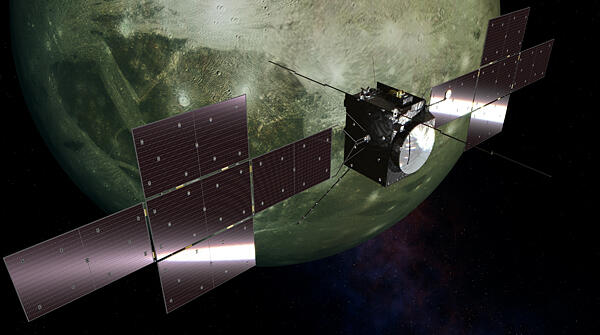
(provided by JAXA).
"Answering the greatest questions of humanity"
JUICE was launched from Europe's Spaceport (also known as the Guiana Space Centre), in French Guiana, South America, aboard the Ariane 5 rocket, at 9:14 p.m. Japan Standard Time (JST) on April 14, 2023. Within 28 minutes of smooth flight, it reached an altitude of 1,500 km, and JUICE was successfully inserted into an Earth escape trajectory. Another 22 minutes later, when the ground station confirmed the signal from JUICE, the controllers celebrated, clapping and embracing each other. "Together, we will keep pushing the boundaries of science and exploration in order to answer humankind's biggest questions," stated ESA Director General Josef Aschbacher. On the night of the 15th of April, the ESA released the first images captured by JUICE as it departed Earth.
This mission marks the ESA's first exploration of the Jupiter system and is a significant step forward in the realization of their long‐term plan, "Cosmic Vision." Collaboratively developed by the Japan Aerospace Exploration Agency (JAXA) and the National Institute of Information and Communications Technology (NICT), the JUICE spacecraft is the largest spacecraft ever constructed for solar system exploration. Weighing in at 6 tons, including fuel, and boasting a width of 27 meters when its solar panels are fully extended, this spacecraft is equipped with a total of ten observation instruments, four of which were developed by JAXA and NICT.
JUICE is scheduled to reach Jupiter's orbit in July 2031 using gravity‐assist "swing‐by" maneuvers, changing its trajectory and velocity by utilizing gravitational assists such as those from Earth, the Moon, and Venus. After carefully observing Jupiter's atmosphere and magnetosphere, as well as conducting 35 close flybys of three of Jupiter's moons to gather information, JUICE will be directed to enter orbit around Ganymede, the largest and most important of these three moons, in December 2034. The mission will conclude by intentionally colliding with Ganymede in September 2035. JUICE is an abbreviation derived from the full name "JUpiter ICy moons Explorer". In celebration of the successful launch of JUICE, I wonder if the team toasted with juice.
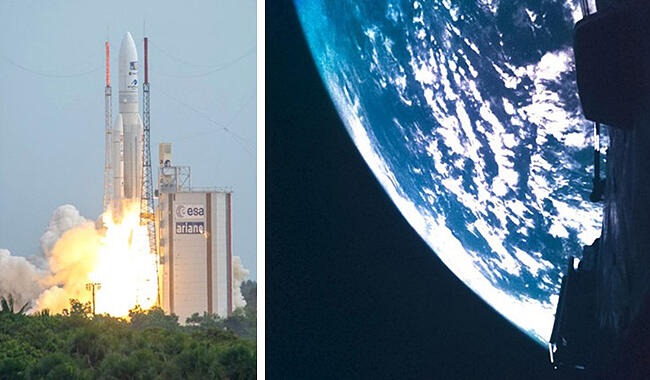
Right: A photograph of Earth taken by JUICE four minutes after its launch
(photo provided by ESA and collaborators.).
Are there oceans on the moons discovered by Galileo?
Yasuhito Sekine, the Director of the Earth‐Life Science Institute at the Tokyo Institute of Technology, is actively involved in researching the origin of life and overseeing scientific investigations for the JAXA team at JUICE. He emphasizes, "Although the JUICE project is primarily led by Europe, Japan plays a crucial role in advancing scientific knowledge. This marks a significant milestone for Japan as we embark on an extraordinary exploration of the gas giant in our solar system, with the potential to uncover insights into the existence of life."
Jupiter is positioned two planets beyond the Earth from the Sun. It has a diameter 11 times that of the Earth and a mass 318 times greater, making it the largest planet in our solar system, and one that almost became a star. Unlike Earth or Mars, Jupiter lacks a solid surface, with the majority of its mass consisting of hydrogen and helium. Therefore, it is classified as a gas planet, along with Saturn.
So, why should we explore the possibility of life on Jupiter? JUICE aims to explore 03 out of the approximately 95 moons orbiting Jupiter, which vary in size. Jupiter has four major moons: Io, Europa, Ganymede, and Callisto, listed in order of proximity to the planet. These moons, known as the Galilean Satellites, were first observed by Galileo Galilei in 1610. With the exception of Io (which exhibits volcanic activity), these are "icy moons," with thick ice covering their surfaces. On these moons, the gravitational pull exerted by Jupiter causes tidal effects that cause the ice to deform, resulting in heat production. As a result, it is thought that subsurface oceans may exist as a result of the ice melting. Sekine confirmed the presence of such an ocean on Europa and stated that Ganymede is also highly likely to have one. For the past decade or so, there has been much discussion about the possibility of life in the oceans of Jupiter and Saturn's icy moons.
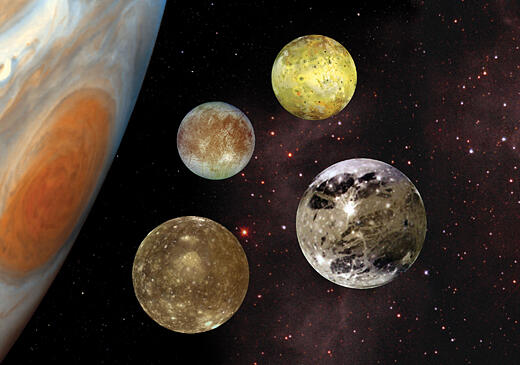
(composite photo provided by the NASA).
Liquid water, organic matter, and energy are three essential elements necessary to support life. It is widely believed that wherever these elements converge on Earth, life thrives. Therefore, it is of great interest to determine whether these three elements are also present on icy moons.
Deep beneath the Earth's oceans lie hydrothermal vents that are heated by magma. In the hydrothermal vents, water, and rocks react at high temperatures, forming a unique ecosystem featuring microorganisms that obtain energy from generated substances such as hydrogen. Similarly, it is possible that such sources of energy and organic matter exist in the oceans of icy moons. If life does indeed exist in these environments, there may be evidence of metabolic activity and specific substances in body parts. Therefore, JUICE will examine the composition of seawater that erupts or falls onto the surface of the icy moons from above.
"In collaboration with experts in geochemistry, geology, and planetary science in Japan, we have already made ground‐breaking discoveries about the composition of the subsurface oceans of Saturn's moons ahead of the rest of the world. Japan is at the forefront and holds a significant advantage," stated Sekine. Based on observational data obtained from probes and replication experiments, it has been firmly established that Enceladus, one of Saturn's moons, bears all three essential components required for supporting life. Additionally, Enceladus exhibits features such as hydrothermal vents on its seafloor.
In contrast, the United States plans to launch a spacecraft (the Europa Clipper) in October 2024. This mission aims to investigate Europa, another icy moon, and will follow in the footsteps of the JUICE mission. At first glance, Jupiter's moons may seem inconsequential; however, the United States and Europe are competing to achieve "the greatest discovery in the history of mankind".
Jupiter's great migration: how does it affect the solar system?
Another focus of JUICE is the clarification of the origins of the solar system. Despite our best efforts, our understanding of this topic remains incomplete.
It is thought that small celestial bodies were first formed from gas and dust clouds in the primitive solar system. Through a series of collisions and interactions, these bodies gradually evolved into planets. Rocky planets are believed to have formed near the sun, where high temperatures caused water to evaporate. In contrast, icy plants were formed in more distant regions of the solar system, where temperatures were much lower. However, over the past 20 years, a series of planets have been discovered beyond the solar system. These newly found planets cannot be explained by previous theories, leading us to reevaluate our understanding of the formation of our solar system.
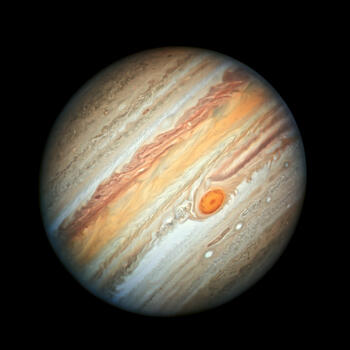
(photo provided by NASA, ESA, and other organizations).
Based on the findings of the asteroid explorer "Hayabusa2" and other observations, we now understand that water and organic matter are distributed throughout various regions of the solar system. Some researchers believe that the migration of Jupiter, with its immense gravitational pull, played a major role in stirring up the solar system and scattering numerous small celestial bodies that contain water and organic matter.
Jupiter is thought to have greatly influenced the formation and arrangement of the solar system. Questions arise regarding when, where, and how the events related to Jupiter's formation and migration occurred. While evidence of these events can be found within Jupiter's gaseous composition, it is challenging to detect such evidence due to the rapid dissipation of the gas. Therefore, it would be advantageous to examine Jupiter's moons, which are composed of solid materials that can retain craters and possess a long history alongside Jupiter. Thoroughly investigating Jupiter's moons is expected to serve as a vital key to understanding the history of the solar system. It may provide insights into the origin of the materials necessary for life and how they may have reached the Earth.
Many giant planets like Jupiter have been discovered beyond our solar system, and it is expected that they will provide clues about the possibility of migration. Sekine explained, "This will help us understand the likelihood of the formation of planets with oceans and atmospheres similar to the Earth's and whether the existence of life is unique."
Towards understanding a magnetosphere different from that of the Earth
Some planets, such as Earth and Jupiter, have magnetic fields that resemble large magnets encompassing the entire planet. In contrast, the sun expels solar wind, which consists of electrically charged particles, or plasma. The magnetic field is suppressed by solar wind, forming a magnetosphere that acts as a protective shield for Earth. Without this magnetic field, the solar wind would blow away the Earth's atmosphere, and without the solar wind, the Earth would be bombarded by harmful particles from the depths of space. By understanding the properties of magnetic fields, magnetospheres, and solar wind, we can deepen our knowledge of physics and gain insights into the conditions that foster life on celestial bodies.
Jupiter, with the strongest magnetic field in the solar system, rotates at high speeds, resulting in a powerful acceleration of the surrounding plasma. Investigating the intricate mechanisms and effects of this phenomenon is another crucial objective of the JUICE mission. The mission aims to study the acceleration of plasma generated by Jupiter's moon, Io, and conduct a detailed examination of Ganymede, the only moon in the solar system known to have a unique magnetic field.
Professor Yoshifumi Saito, the JAXA team leader in the JUICE project, emphasized that "Ganymede's unique magnetosphere is located in Jupiter's massive magnetosphere. We want to deepen our understanding of the phenomenon by studying what occurs under these unique conditions different from that of the Earth." Sekine added, "Plasma observations are also important for the study of extraterrestrial life." This is because the plasma striking the surface of an icy moon causes the ice to decompose, producing oxygen and other substances.
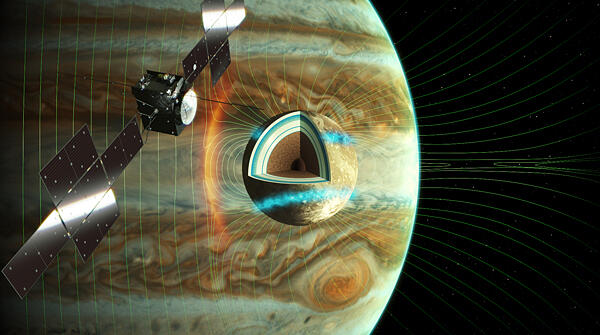
(photo provided by JAXA).
Japan plays an important role in instrument development
Japan has played a key role in developing four observation instruments for JUICE. One of these instruments, known as "the Terahertz Spectrometer," was developed by NICT to observe the moons' atmospheres and surfaces. Another instrument, "the Ganymede Laser Altimeter," was developed by JAXA to study the topography of Ganymede. JAXA also led the development of other variations, including "the Plasma Environment Observation Package—Non‐thermal Particle Analyzer" to observe neutral particles created by plasma collisions, "the Radio and Plasma Wave Observations Instrument," which helps in understanding the magnetosphere, moon atmosphere, and subsurface ocean. Japan is involved in all scientific research themes of the JUICE mission. Alongside Japan, the United States and Israel are also joining the JUICE project.
Associate professor Keigo Enya of JAXA, who is responsible for the laser altimeter, explained, "If Ganymede has a subsurface ocean, tidal forces should deform this planet. If the subsurface were solid, no deformation would occur. We will be able to determine the presence or absence of an ocean through measurements."
Japanese researchers have maintained a keen interest in Jupiter for several years, and they once contemplated developing their own spacecraft for exploring the Jupiter system. Regrettably, their plan was abandoned due to budget cuts resulting from the impact of the Tōhoku earthquake and tsunami in 2011. The anticipated arrival of JUICE on Jupiter is still eight years away. Nevertheless, until then, we should maintain high expectations, not only within the scientific community but also among ourselves.
Comprehensive knowledge is required to understand life
In recent years, Japan's exploration of the solar system has garnered considerable attention, particularly the Hayabusa and Hayabusa2 missions. It should be noted that exploration efforts are underway across a wide range of celestial bodies, from Mercury to Jupiter. One such mission is the joint Japan‐Europe Mercury Exploration Mission, "BepiColombo," which is currently underway with the aim of reaching Mercury by the end of 2025. Another notable mission is the Venus Climate Orbiter "AKATSUKI," which overcame several challenges and was successfully inserted into Venus' orbit in 2015. It continues to operate to this day. Furthermore, there is the "MMX" mission, which aims to collect samples from Phobos, one of Mars' moons, and bring them back to Earth.
Regarding the moon, JAXA's "SLIM" mission aimed to demonstrate high‐precision soft‐landing technology. In the private sector, the lunar lander of the space venture company Ispace Inc. (Tokyo) carried out the "HAKUTO‐R" mission and made an attempt at a soft landing on the lunar surface on April 26th, 2023, but unfortunately failed.
In conclusion, as an author in my fifties, I hope that within my lifetime, humanity will discover scientific evidence of extraterrestrial life, even if I am unable to witness the existence of extraterrestrial life itself. We are now on the eve of the "Discovery of Extraterrestrial Life." At least, life would become a little more enjoyable if we entertained such thoughts. Akutagawa continued after the sentence mentioned at the beginning of the article: "Life on Mars may be coming to Ginza with the autumn wind again tonight." While I am not certain that they are in Ginza, there is a possibility of life on Mars, living quietly beneath the surface, even in the form of microorganisms.
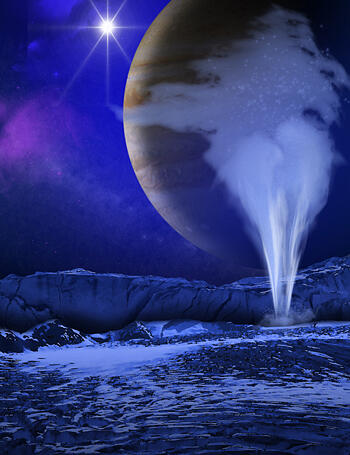
(photo provided by NASA, ESA, and other organizations).
The more we come across news about solar system explorations such as JUICE, exoplanet observations, and theoretical research, the more our expectations grow. There may be compelling signs of life, but it is difficult to obtain confirmation because we cannot send spacecraft to exoplanets. Conversely, if the indications of life continue to be elusive, how can we detect them? To gain a profound understanding of life, comprehensive knowledge is required, linking information not only from various scientific and engineering disciplines but also from the humanities and social sciences. Collaboration across these fields is essential. Exploring extraterrestrial life will teach humanity the significance of our planet and offer a fresh perspective on how to improve our lives and make the most of the resources available to us.
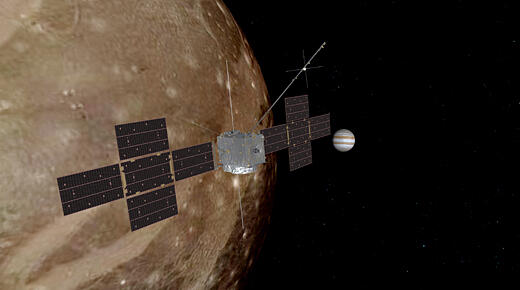
(photo provided by ESA).
(KUSAKA Takeo / Science Portal Editorial Office)
Original article was provided by the Science Portal and has been translated by Science Japan.




